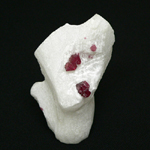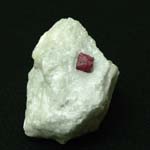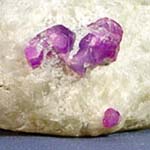Stone, minerals and semiprecious of the world stone
Spinel (oxides): Spinel -->rus
 Diagnostic cart.
Diagnostic cart.
On a photo. Crystals noble spinel on white Calcite. Down: the crystals of dark blue spinel (Franclin, New Jersey).
Mg Al2 O4
Crystal structure cube
Hardness on the Mohs scale 8
Specific unit weight mass 3,6-3,75
Cleavage non-existent
Fracture, break padman
Colors colourless, red, dark blue, blue, brown-black
Colors in powder triturate white
Glance (glitter, glare) glassy
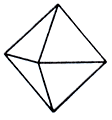
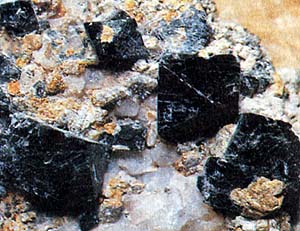 Got the name Spinel, probably, on a form crystals: from Latin spinella is a little thorn. Spinel is almost all of flowers, but ruby-red stone colouring of which is conditioned the presence of chrome are most valued. Large transparent stone present large rareness. Zvezdchataya Spinel is especially rare with a 4-radial star. Dark blue variety spinel sensible to the increase of temperature. A hard, glassy mineral composed of magnesium-aluminium oxide found in metamorphosed limestones and many basic and ultrabasic igneous rocks. Formula: MgAl2O4.
Got the name Spinel, probably, on a form crystals: from Latin spinella is a little thorn. Spinel is almost all of flowers, but ruby-red stone colouring of which is conditioned the presence of chrome are most valued. Large transparent stone present large rareness. Zvezdchataya Spinel is especially rare with a 4-radial star. Dark blue variety spinel sensible to the increase of temperature. A hard, glassy mineral composed of magnesium-aluminium oxide found in metamorphosed limestones and many basic and ultrabasic igneous rocks. Formula: MgAl2O4.
Rifle-green and black opaque Spinel name Ceylonite pleonaste (there is Sri Lanka on the old name of island), however preferably for it the name "pleonaste". that in Greece means "surplus", for plenty of verges at crystals. Shpineli name a brown variety picotite, yellow - rubycille (diminutive form from French "ruby"), and rose - balas- or bale-ruby (at the place of find in Afghanistan).
As independent mineral Spinel began to select only one and a half centuries back. To that it was added on rubies, especially as in nature a ruby and Spinel quite often meet together. Some of famous historical rubies spinel appeared on a check, for example such stone from the treasure-house of the Britannic crown, as oval 5-centimetre "Ruby of the Black prince" in the crown of England and "Ruby Timura" by mass a 361 kar in a breast chain. Both these the stone of polish float only on natural verges. Kaplevidnye spinel in Vittelsbakhskiy also considered a crown (1830) rubies. Spinel appeared and "ruby" by mass 398,72 carat in large emperor's crown of Ekateriny II. Made in 1762 A. Poze.
It is also named by noble spinel for beauty of crystals, in-use on jeweller business. Can have the different colouring - from brown-black (conditioned the presence of iron - pleonaste) to dark blue, from colourless to ruby-red (red Spinel). Glance (glitter, glare) glassy. In nature crystals are often observed in a perfect octahedral form and usually paired twin (duplex). Various inclusion of black octahedrons of Herzenite (rare spinel with an aluminium and bivalent iron), oriented as parallel filaments register in red and blue spinel. In addition, the well well-educated crystals of Calcite, dolomite, apatite, zircon, olivine and rutile can be present.
Chemical composition (chemistry, compound) is maintenance (in %): MGO - 28,2; Aloz - 71,8; the admixtures of iron, chrome, zinc, manganese are ordinary. Hexaoctahedral type of symmetry. Cleavage - noperfect absolute to on (111). Be found mainly in form octahedral crystals (other simple forms are rare) usually small sizes. Twins of accretion are characteristic to on (111) - on a spinelian law. Isometric grains and grainy aggregates are less widespread. At the real crystals spinel usually one is most developed or pair of opposite verges of octahedron. Thus spinel twins acquire a characteristic triangularly-lamellar tabular type with the divided (entering) corners.
Lale - red Spinel, adamantine, transparent, with strong glass brilliance. Blood-red Spinel, the color of which is conditioned salts of chrome, a ruby extraordinarily reminds. From the chemical point of view Spinel is a difficult oxide of magnesium and aluminium.
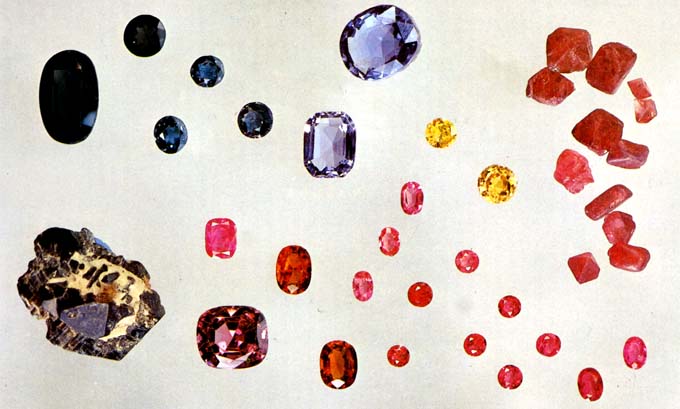
Diagnostic indication.
Spinel fluorescent in ultraviolet rays enough intensively. A rose variety at heating acquires the light-yellow colouring; however at cooling a primary color is restored.
Origin provenance genesis.
Spinel is revealed in carbonate, magmatic rocks and in slates. For the use as a jewel it is obtained mainly from alluvial deposits.
Deposit minefield mine field occurrence subsoil.
Deposits are most glorified in Cambodia, India, Burma, Thailand and Sri Lanka. Spinel is exposed in Brazil (state of Es-piritu-santu), on Ural, in Australia, on Madagascar and in the United States.
Basic deposits spinel is mineral deposits of Burma (р-н of Mogoka) and Sri Lanka. Considerably a less value is had find in Anatoliy (Turkey). Afghanistan. To Brazil. Thailand, USA (state is New Jersey). In the CIS deposit spinel present on Pamire. Two largest crystals spinel (one strongly rounded gravel, other in form octahedron) by mass for 520 carat each are in the Britannic museum of natural history in London.
Synthetic Spinel acted to the market in 20th of XX age. It is imitated by it not only natural Spinel but also many other stone. Easily to entangle Spinel with Amethyst, by a chrysoberyl, Garnet, by a ruby, Sapphire, by topaz. However much specialists diagnose Spinel very simply - on absence for it of birefringence.
Use, practical application, deployment.
Application spinel on jeweller business all know well. Copies, not suitable on the qualities for these aims, are used in the production of abrasive powders and at making of clock-works.
The use is on jeweller business.
Jeweller varieties spinel is obtained from alluvial deposits. The red (ruby Spinel, or Ruby-bale) are especially valued, and also dark blue and green spinel. Cutting more frequent than all oval. For transparent and translucent varieties apply cutting as cabochons or sphere. Many known stone, before considered rubies, are now redefined as spinel. From them it is needed to mention famous "Ruby of black prince", or "Ruby of Timure" (his primary origin - from India), kept in Treasure-house of the Britannic crown.
Cost spinel enough high, but very considerably varies depending on a color, that depends both on popularity and from a presence at the market. To the present tense the vast number of synthetic single-crystals is known. However only some of them found the wide enough use on jeweller business.

